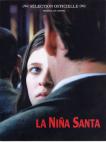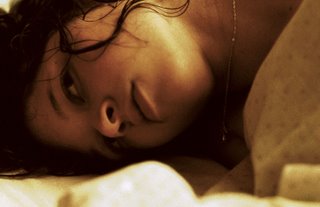Lucrecia Martel's The Holy Girl

I had wanted to see Martel's La Ciénaga, her first feature, but had access to her second, La niña santa/The Holy Girl. Wow, what an amazing talent Martel is. But what I like the most is her use of sound, particularly as connective tissue between scenes and how she uses sound in the final scene of the film (plus the narrative and soundtrack feature a theremin! If you go to the website that's the instrument playing). I found myself unable to focus all the way through, I think it was an uncomfortably claustrophobic film, both in its emotional content and cinematic grammar. A good example is Martel's close ups with over the shoulder shots with out of focus ears of the listener or watcher and the in focus shot of Amalia's bisected face which actor María Alché invests with such teenage coming of age complexity I felt like I was under her skin (see left). The sensation reminded me of why I'm grateful to no longer be a teenager. Even with some of the tight shots Martel gives her actors a lot of emotional space to work their instrument. I realize this is an atypical experience for me as a viewer. As director Alison Anders has pointed out, popular US contemporary film structure has developed through increasingly quick edits, so actors have little time to actually practice their craft within a shot. There are of course exceptions, recent ones include Anders' own Things Behind the Sun and Spike Lee's The 25th Hour . In general character driven work encourages employment of the old adage that 70% of the success of a film comes from casting. So already you're dealing with a history that has formed outside of a film's production, gathering actors that can hold the energy of a scene, particularly a stillness which I think is an amazing skill.
Ah, but Martel, she casts María Alché as Amalia, the niña santa in question who reminds me of a young Jeanne Moreau, and a little bit of Michelle Rodriguez in Girlfight, in the eyes.
 But the gaze of Alché's Amalia is focused in such a different manner than that of Rodriguez's Diana. Amalia is emerging from the comparatively simple focus of childhood to that juncture when girls become both beacons and attractors of various gazes forcing the refractions of a number of points of light. OK, I'm working on that metaphor. I mean to say that while Diana is emerging from a morass of confusion and anger, the discipline and boundaries of the boxing ring and what must be done within it focuses her emotions and allows her to access her core self which is more than just an embodied reaction to her father's failings and her mother's suicide. Amalia is part of her Catholic church's religious group for young girls in which the girls engage in earnest theological discussion, most recently on the subject of vocation. The stories of women's vocational calling collected by the girls featuring precipitators of mayhem and bloody deaths and other explosive encounters, with their car crash and expelling of bodily fluid symbolism, seem to speak to the conflation of the girls' erupting hormones with their search for a vocation. This is particularly true for Amalia whose surrounding world, the protracted adolescence of a mother (the amazing Mercedes Morán who was in La Ciénaga, and played Celia de la Serna in Diarios de motocicleta/The Motorcycle Diaries) and uncle (Alejandro Urdapilleta) who have raised her in the, as of late, crumbling playground of the family hotel seems to have left her both vulnerable to the whims of strangers (one in particular played with anxious normalcy by Carlos Belloso) and hungry for a higher purpose. Another fascinating aspect of Martel's filmmaking is that she doesn't believe in audiences losing themselves while watching her films, or any film. She doesn't believe that losing oneself makes for the best filmgoing experience. Instead if the film makes them reflect on their lives while watching the it that's the desired experience. I wondered if this was Brechtian influence, except she's not alienating the audience with a preponderance of artiface or by creating less than a total environment. But it was interesting to me because it was the first time I've ever heard a filmmaker posit that view of the film audience's experience. The upshot is there are some amazing performances across about three generations in this film, with the two young actors at the center of the story turning in some incredibly thoughtful work.
But the gaze of Alché's Amalia is focused in such a different manner than that of Rodriguez's Diana. Amalia is emerging from the comparatively simple focus of childhood to that juncture when girls become both beacons and attractors of various gazes forcing the refractions of a number of points of light. OK, I'm working on that metaphor. I mean to say that while Diana is emerging from a morass of confusion and anger, the discipline and boundaries of the boxing ring and what must be done within it focuses her emotions and allows her to access her core self which is more than just an embodied reaction to her father's failings and her mother's suicide. Amalia is part of her Catholic church's religious group for young girls in which the girls engage in earnest theological discussion, most recently on the subject of vocation. The stories of women's vocational calling collected by the girls featuring precipitators of mayhem and bloody deaths and other explosive encounters, with their car crash and expelling of bodily fluid symbolism, seem to speak to the conflation of the girls' erupting hormones with their search for a vocation. This is particularly true for Amalia whose surrounding world, the protracted adolescence of a mother (the amazing Mercedes Morán who was in La Ciénaga, and played Celia de la Serna in Diarios de motocicleta/The Motorcycle Diaries) and uncle (Alejandro Urdapilleta) who have raised her in the, as of late, crumbling playground of the family hotel seems to have left her both vulnerable to the whims of strangers (one in particular played with anxious normalcy by Carlos Belloso) and hungry for a higher purpose. Another fascinating aspect of Martel's filmmaking is that she doesn't believe in audiences losing themselves while watching her films, or any film. She doesn't believe that losing oneself makes for the best filmgoing experience. Instead if the film makes them reflect on their lives while watching the it that's the desired experience. I wondered if this was Brechtian influence, except she's not alienating the audience with a preponderance of artiface or by creating less than a total environment. But it was interesting to me because it was the first time I've ever heard a filmmaker posit that view of the film audience's experience. The upshot is there are some amazing performances across about three generations in this film, with the two young actors at the center of the story turning in some incredibly thoughtful work.

0 Comments:
Post a Comment
<< Home